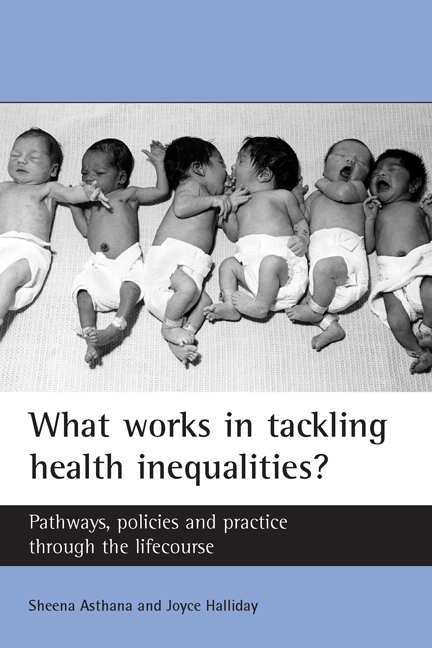Book contents
- Frontmatter
- Dedication
- Contents
- List of tables, boxes and figure
- Acknowledgements
- List of abbreviations
- one Introduction
- Part 1 The research and policy context of health inequalities
- Part 2 Health inequalities pathways, policies and practice through the lifecourse
- Part 3 Tackling health inequalities: developing an evidence base for public health
- Index
eleven - Health inequalities during adulthood: policy and practice
Published online by Cambridge University Press: 14 January 2022
- Frontmatter
- Dedication
- Contents
- List of tables, boxes and figure
- Acknowledgements
- List of abbreviations
- one Introduction
- Part 1 The research and policy context of health inequalities
- Part 2 Health inequalities pathways, policies and practice through the lifecourse
- Part 3 Tackling health inequalities: developing an evidence base for public health
- Index
Summary
Introduction
Chapter Ten showed how socio-economic conditions during adulthood continue to exert a powerful impact on health and behaviour. This chapter retains the focus on the key sources of vulnerability, lifestyle, psychosocial health and material living conditions, as we seek to examine the evidence base for what works and its relationship to the policy environment. We note, however, that the boundaries are increasingly indistinct. Housing, for example, has a significant material dimension reflected in housing costs, the generation of wealth, a controlled physical environment and protection from the elements. It also has a significant psychosocial dimension, reflecting self-identity, social status and autonomy (Dunn, 2002).
The material determinants of health are also linked themselves in a multiple, complex and contingent manner. This was recognised in policy terms by The health of the nation (DH, 1992), where the Conservative government argued the need to inject a health dimension into all public policies (Smith and Mallinson, 1997), and the Department of the Environment (DoE) agreed that health improvements should be an aim of urban regeneration. The White Paper Saving lives: Our healthier nation (DH, 1999a) similarly stressed the need to address the social, economic and environmental determinants of health as well as lifestyle choices, and stressed the importance attaching to integrated policy making.
Such concern, while relatively recent, makes the task of distinguishing effective interventions and appropriate policy ever more hard. It highlights the dissonance between downstream and upstream policy, between the evidence-based agenda with its focus on individualised interventions and the continuing requirement for structural solutions (see Chapter Fourteen). It also illuminates the difficulties of the midstream, where attempts to achieve national policy objectives via local area-based initiatives (ABIs) reveal the tension between place-based and people-based policies (Joshi, 2001). Additionally, it challenges attempts at classification by demanding a holistic approach to health inequalities and, as in so many other instances, finds the actual evidence to be limited.
One contributory reason is that, despite the rhetoric, health remains on the margins of the regeneration agenda and the effects of changing or ameliorating deprivation on population health have received relatively little attention, partly because it is managed by organisations that are not part of the health sector (Curtis et al, 2002).
- Type
- Chapter
- Information
- What Works in Tackling Health Inequalities?Pathways, Policies and Practice through the Lifecourse, pp. 417 - 474Publisher: Bristol University PressPrint publication year: 2006



